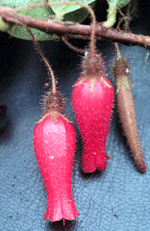James L. Luteyn and Paola Pedraza-Peñalosa
The New York Botanical Garden
|
|
Oreanthes is a genus of seven species of epiphytic shrubs found in montane
habitats in Ecuador and adjacent northern Peru. Six species are endemic
to Ecuador and there are only two collections from one species in N Peru.
The genus is characterized by sympetalous flowers, inferior ovaries, calyces
continuous with the pedicels, 5(-10) stamens, tubules narrower and much
longer than the thecae, terminal dehisce by short, oval and oblique or
perfectly terminal pores, and berry fruits. Oreanthes represents
a rather distinct evolutionary line and I am still unable to suggest with
confidence its relationships to other genera in the Vaccinieae. Bentham (1844) named and described Oreanthes in his Plantae Hartwegianae. The genus was thus treated as monotypic until Smith (1952) described a second species. Luteyn (1996b) revised the genus in its entirety. The genus as a whole, as well as each of the seven species, must be considered in extreme danger of extinction because the localities and habitats in which they have been found are all undergoing severe alteration at the present time. |
OREANTHES Bentham, Pl. hartweg. 140. 1844); Luteyn, Fl. Ecuador 54: 329-337. 1996. Type: Oreanthes buxifolius Bentham.
Terrestrial or epiphytic shrubs, often trailing subshrubs; indumentum (when present) of simple or multicellular, glandular hairs. Leaves alternate, thick-coriaceous and usually succulent when fresh, usually obscurely 3 (-5-7)- plinerved, short-petiolate. Inflorescence axillary, of solitary or paired flowers, rarely with up to 3 flowers in a fascicle; floral bract and bracteoles minute, often caducous. Flowers 5-merous, without odor; aestivation valvate; calyx continuous with pedicel; hypanthium terete to bluntly 5-angled, glabrous to glandular pubescent; corolla cylindric, terete to angled, red to scarlet, glabrous to glandular pubescent; stamen 5 or 10, equal, nearly as long as corolla, rarely longer; filaments distinct or connate, shorter than the anthers, lacking spurs; anthers lacking disintegration tissue; thecae essentially smooth; tubules slightly longer to up to 6 times longer and about 1/2 the width of the thecae, dehiscing by terminal or subterminal and oblique, usually slightly flaring pores, rarely elongate clefts; pollen lacking viscin threads; ovary inferior; style slightly exserted; nectariferous disk usually obscure or rarely annular-pulvinate. Fruit a berry. Chromosome number unknown.
Key to Neotropical Species Back to Top
1. Stamen 5.
2. Filaments connate into a tube 4-10
mm long; anther thecae about one-half
the length of
the anthers .................................................................. O. buxifolius.
2. Filaments essentially distinct, 1.5-5.5
mm long; anther thecae one-quarter
to one-seventh
the length of the anthers.
3. Leaves
orbicular, less than 2.5 cm long ...................................... O. rotundifolius.
3. Leaves
ovate to elliptic-ovate, 2-4 cm long.
4. Flowers (especially calyx and pedicel) conspicuously glandular-hispid;
stamen dehiscing by strictly terminal pores ............................ O. glanduliferus.
4. Flowers pilose, without glandular hairs; stamen dehiscing
by obliquely
terminal pores ......................................................................... O. ecuadorensis.
1. Stamen 10.
5. Leaves 1.5-4 x 1-2 cm, the apex rounded
to obtuse, the petiole not pulvinate;
pedicel 15-30
mm long; staminal tubules apically acuminate and not flaring,
dehiscence by
oblique clefts .............................................................. O. fragilis.
5. Leaves 3.5-7.5 x 2.5-6 cm, the apex
rounded or abruptly short-acuminate,
the petiole
conspicuously pulvinate or not; pedicel 4-20 mm long; staminal
tubules apically
truncate and flaring, dehiscence by terminal or slightly oblique
pores.
6. Leaf
apex rounded, the petiole conspicuously pulvinate; pedicel 4-8 mm
long; anther thecae basally glabrous ............................................. O. hypogaea.
6. Leaf
apex abruptly short-acuminate, the petiole not pulvinate; pedicel
11-20 mm long; anther thecae basally densely tufted pubescent .... O. sperlingii.
This is a version of the taxonomic treatment by James L. Luteyn. The full treatment including specimen citations may be see in the Flora of Ecuador (Luteyn, 1996b).
